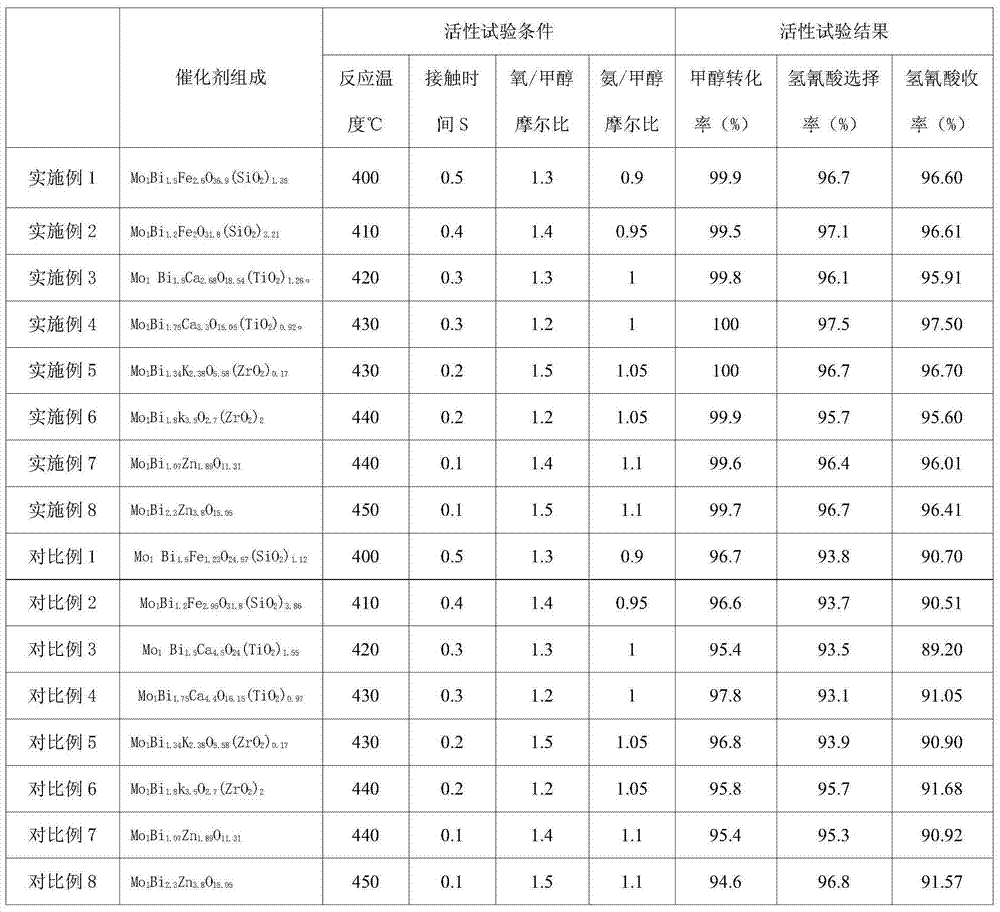Catalyst for preparing hydrocyanic acid by adopting methanol ammonia oxidization as well as preparation method and application of catalyst for preparing hydrocyanic acid by adopting methanol ammonia oxidization
A catalyst, hydrocyanic acid technology, applied in metal/metal oxide/metal hydroxide catalyst, physical/chemical process catalyst, preparation/purification/separation of hydrogen cyanide, etc., can solve the unknown effect and weight , complex catalyst combination, difficult to grasp the catalyst ratio and other problems, to achieve the effect of clean production, reduction of ammonia oxygen content, and convenient preparation
- Summary
- Abstract
- Description
- Claims
- Application Information
AI Technical Summary
Problems solved by technology
Method used
Image
Examples
Embodiment 1
[0041] Embodiment 1 (catalyst 1)
[0042] Dissolve 23.5g of molybdenum chloride in 300ml of water to form a solution, add 85.0g of bismuth nitrate and 54.5g of ferric nitrate in batches, and form a mixed solution with 16.3g of ethylenediamine (total mass 10%).
[0043] Under the condition of sufficient stirring, 82 g of silica sol (50% of the total mass) was added into the mixed solution, and heat-treated at 100° C. while stirring to form a slurry. The slurry was then spray dried using a rotary disc spray dryer. The resulting fine spherical particles were calcined at 200 °C for 6 h and at 750 °C for 1 h.
[0044] The prepared catalyst obtains the following experimental formula:
[0045] Mo 1 Bi 1.5 Fe 2.6 o 36.9 (SiO 2 ) 1.35
Embodiment 2
[0046] Embodiment 2 (catalyst 2)
[0047] 24.4g of molybdenum oxide was dissolved in 300ml of water to form a solution, and 98.5g of bismuth nitrate and 91.5g of ferric chloride were added in batches to form a mixed solution with 17.15g of gluconic acid (8%).
[0048] Under the condition of full stirring, 192.96 silica sol (90%) was added into the mixed solution, and heat treated at 100°C while stirring to form a slurry. The slurry was then spray dried using a rotary disc spray dryer. The resulting fine spherical particles were calcined at 250 °C for 4 h and at 700 °C for 2 h.
[0049] The prepared catalyst obtains the following experimental formula:
[0050] Mo 1 Bi 1.2 Fe 2 o 31.8 (SiO 2 ) 3.21
Embodiment 3
[0051] Embodiment 3 (catalyst 3)
[0052] 32.5g of molybdenum nitrate was dissolved in 300ml of water to form a solution, and 79.75g of bismuth carbonate and 56.0g of calcium carbonate were added in batches to form a mixed solution with 37.2g of lactic acid (15%).
[0053] Under the condition of sufficient stirring, 148.8 g of silica sol (60%) was added into the mixed solution, and heat-treated at 100° C. while stirring to form a slurry. The slurry was then spray dried using a rotary disc spray dryer. The resulting fine spherical particles were calcined at 300 °C for 3 h and at 650 °C for 3 h. The prepared catalyst obtains the following experimental formula:
[0054] Mo 1 Bi 1.5 Ca 2.68 o 18.54 (TiO 2 ) 1.26 .
PUM
 Login to View More
Login to View More Abstract
Description
Claims
Application Information
 Login to View More
Login to View More - R&D
- Intellectual Property
- Life Sciences
- Materials
- Tech Scout
- Unparalleled Data Quality
- Higher Quality Content
- 60% Fewer Hallucinations
Browse by: Latest US Patents, China's latest patents, Technical Efficacy Thesaurus, Application Domain, Technology Topic, Popular Technical Reports.
© 2025 PatSnap. All rights reserved.Legal|Privacy policy|Modern Slavery Act Transparency Statement|Sitemap|About US| Contact US: help@patsnap.com


